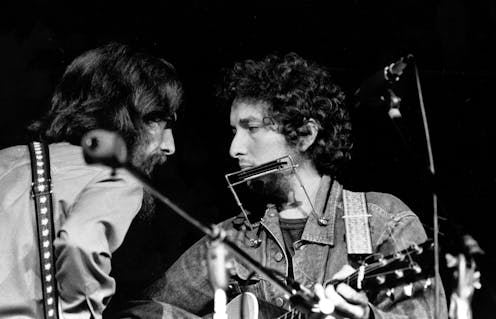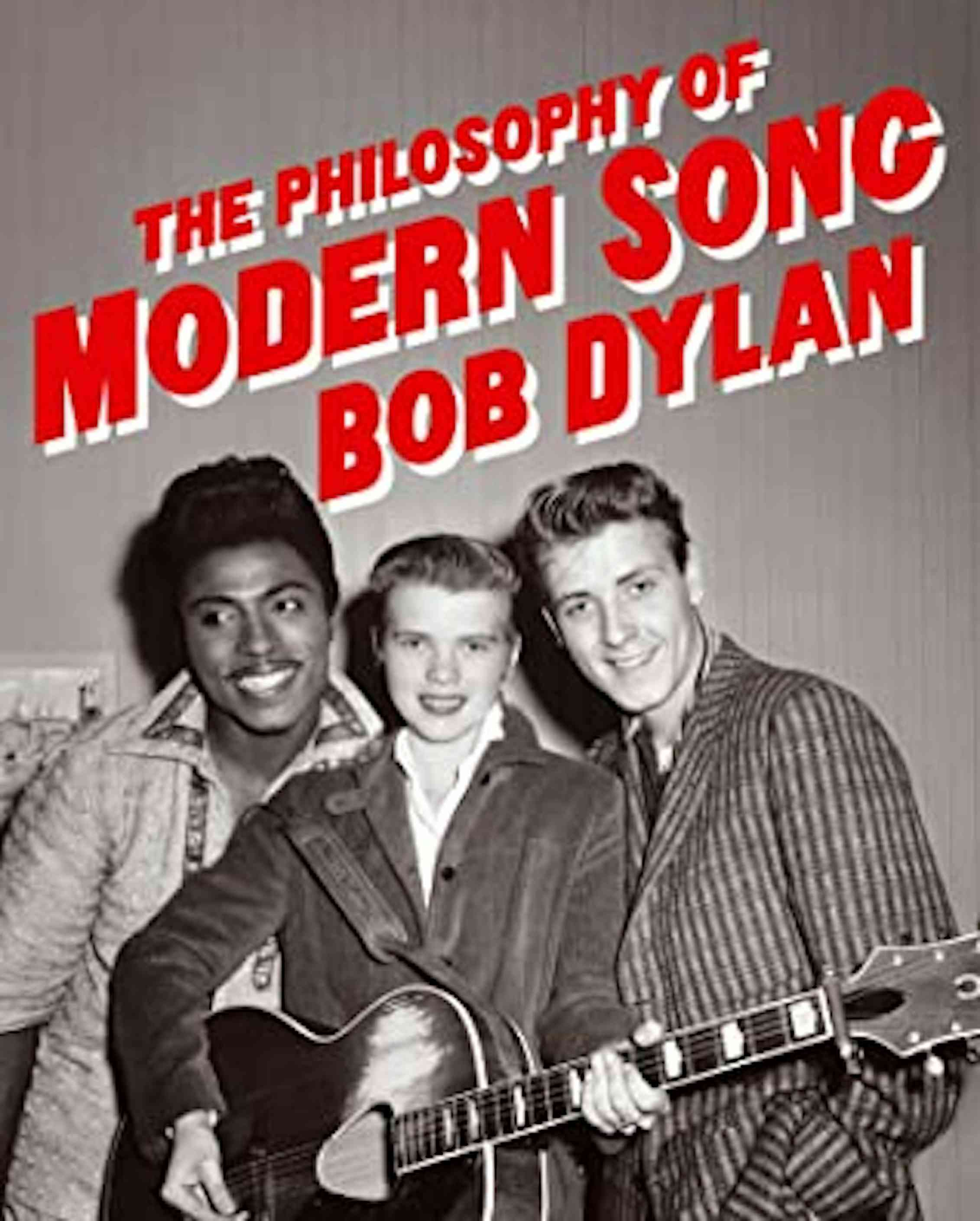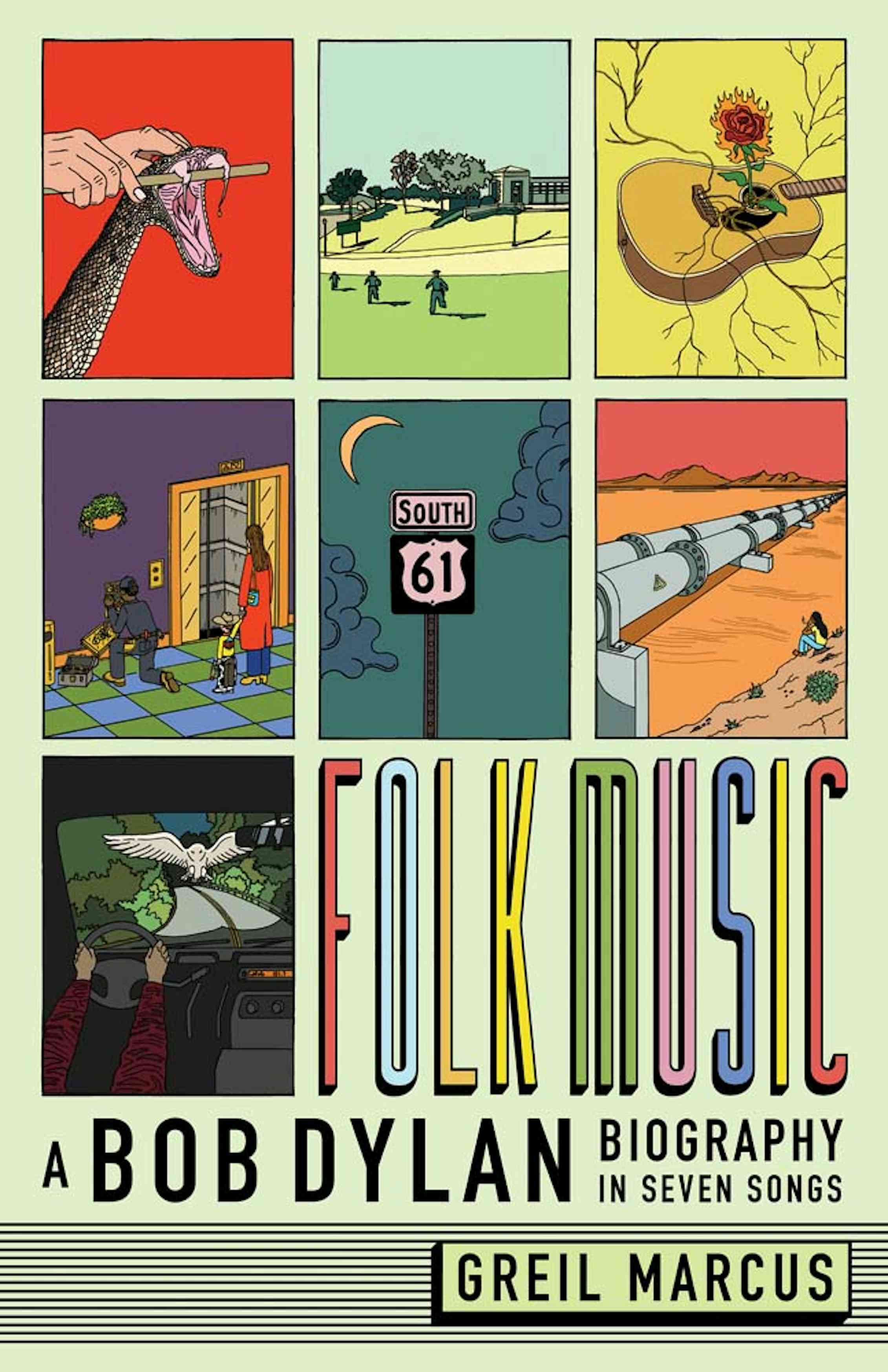
Bob Dylan, sing-songwriter and Nobel laureate, has spent a career confounding expectations. What, then, should one expect of his new book, The Philosophy of Modern Song? Firstly, “modern song” should read “American modern song”, since almost all of the 66 songs discussed by Dylan are American. And by “modern”, we are talking mid-century, mostly from the 1940s to the 1960s. Stylistically and generically, the songs cover the Great American Songbook, folk, rock’n’roll, country, and so on.
The Philosophy of Modern Song – Bob Dylan (Simon & Schuster, 2022)
Folk Music: A Bob Dylan Biography in Seven Songs – Greil Marcus (Yale University Press, 2022)
In other words, they are the kinds of Americana that can be found on Dylan’s own records. “Philosophy” is the kind of word that can mean anything in publishing contexts, and it should warn the reader not to expect anything so programmatic as, for instance, a history of modern song.
Dylan’s choice of songs forms a mood more than a method. The book is populated by outlaws, grifters, cowboys, gangsters, con artists, and gamblers. There are also references to hucksters like the Colonel Tom Parker (Elvis Presley’s manager) and the 19th-century showman PT Barnum. And to rubes (or those easily duped). So, reader, be aware: this book is concerned with “modern song” on its own terms.

Each song is a springboard for two different kinds of riffing. Firstly, there are eccentric fictions that relate tangentially, if at all, to the particular song (though many reconfigure lyrical elements of the song in question). Written in the second person, these pieces have all the allure of someone narrating a dream, which is to say (for me), not much.
Full of Dylanesque imagery, these dream pieces lack the strangeness (and music, of course) of Dylan’s mid-60s period, but they have that period’s semi-prophetic loquaciousness, mixing the everyday with the apocalyptic.
For instance, the chapter on Everybody Cryin’ Mercy by the jazz and blues artist Mose Allison has you
Thumbing a ride on the Ferris Wheel, shooting ducks and winning kewpie dolls, while all of mankind cries mercy – every race, creed, and color – rich and poor from all quarters, all over creation.
There are some startling moments in these pieces, but cumulatively they have the air of AI-generated prose.
More interesting, are the essays that follow the dream pieces. Like those pieces, the essays are often tangentially related to the song in question. Sure, we learn a little about Townes Van Zandt (his family wanted him to be a lawyer) or the link between Rosemary Clooney, Armenian folk song, and Alvin and the Chipmunks, but these essays are mostly an occasion for Dylan to muse (philosophise) on everything from the movies, polygamy, and lemmings, to language, history, and war. Or, as the dust jacket of the (very nicely designed and lavishly illustrated) book grandly puts it, “the human condition”.
A gender imbalance
Like the dream pieces, the essays are associative and riffing in nature, but they are more interested in imparting information.
The essay on Nina Simone’s Don’t Let Me Be Misunderstood begins with an account of the problems that the first sentence of the novel L’Étranger (by fellow Nobel laureate, Albert Camus) has given translators, then moves onto a potted history of Esperanto, followed by some notable examples of misunderstanding, before briefly landing on Simone’s recording of the song, which in turn becomes an opportunity to talk about the relationship between art and interpretation. On this last subject, it is hardly surprising that the “mercurial” Dylan should assert that
Art can be appreciated or interpreted but there is seldom anything to understand.
Talking of Simone, she is only one of three female artists covered here. Coupled with Dylan’s thoughts, presumably baiting, on polygamy and feminism, as well as the often-misogynistic representations of women in the dream pieces (climaxing on the Eagles’ Witchy Women), one can only wonder if Dylan doesn’t have a “woman problem”.
But, as always with Dylan, it is hard to know how seriously to take any of this. Is he riffing on the misogyny of his source material or just engaging in it himself? This question brings to mind the arguments surrounding much stand-up comedy (that other source of the word “riff”.)
But all of this makes The Philosophy of Modern Song sound more solemn than it is. The book is filled with genuine, and informed, enthusiasm for many of the songs discussed, such as the Fugs’ CIA Man and the Osborne Brothers’ Ruby, Are You Mad?, the latter of which leads to the unexpected, but not entirely ridiculous, assertion that bluegrass is “the other side of heavy metal”.
Dylan likes these sort of apothegms: “There are more songs about shoes than there are about hats, pants, and dresses combined”; “There is nothing scarier than someone earnest in their delusion”.
A lot of fun
The best parts of the book are when you are in on the joke, or when Dylan is just flat-out funny. Anyone who knows anything about the Grateful Dead would have to laugh at the deadpan assertion that they are “essentially a dance band”. (But since Dylan’s recorded an album with them, perhaps he knows best.) Dylan also does a good satirical side-order in grumpy-old-man-isms. For instance, on food he writes that
There isn’t an item on the menu that doesn’t have half a dozen adjectives in front of it, all chosen to hit you in your sociopolitical-humanitarian-snobby-foodie consumer spot. Enjoy your free-range, cumin-infused, cayenne-dusted heirloom reduction. Sometimes it’s just better to have a BLT and be done with it.
That observation was from the essay on Your Cheatin’ Heart by Hank Williams. There are lots of instances of gerunds (“-ing’ words) missing their terminal g’s in The Philosophy of Modern Song, and not just when it comes to song titles. Elvis (Presley, not Costello) is described as "backwoods-born but city-livin’, truck-drivin’, hip-shakin’ with a feral whiff of danger”. The fact that the complex adjectives get their hyphens makes it clear that Dylan is havin’ fun with his gerunds.
And this book is mostly about fun (though things get serious when Dylan talks about the plight of Native Americans and war). When I ignored the high-falutin’ talk on the blurb and press release, I got a lot of fun (rather than philosophy) from this book.
If nothing else, notwithstanding the gender bias, the book makes up a terrific playlist. I can’t imagine any reader who wouldn’t discover some unknown gems. Two of my favourite discoveries were the book’s most recent songs (from 2001 and 1986): Doesn’t Hurt Anymore by John Trudell, and Old Violin by Johnny Paycheck, just two of the numerous Johns and Johnnies who populate this work.
Much of the milieu covered in The Philosophy of Modern Song converges with the American music that Greil Marcus wrote about in his groundbreaking book, Mystery Train: Images of America in Rock’n’Roll Music (1975).
Being a critic, Marcus is more disciplined than Dylan, but, like him, his technique is based on riffing, on finding unexpected connections amid arcane knowledge.
Marcus has written a number of books about Dylan, including a book on the Basement Tapes that Dylan made with the Band, the second edition of which was called The Old Weird America. The America dealt with in Marcus’s latest book on Dylan, Folk Music: A Bob Dylan Biography in Seven Songs, might be less old, but it certainly remains weird.

A nation’s shared vernacular music
Like The Philosophy of Modern Song, the title of Marcus’s latest book is a little inaccurate, since it is not really a biography of Dylan, except inasmuch as a biography of America is a biography of its national songwriter.

Just as Marcus did in The History of Rock’n’Roll in Ten Songs (2014), and Dylan does in The Philosophy of Modern Song, the songs in Folk Music are launching pads for wide-ranging meditations – in this case about Dylan and American history and culture.
Indeed, Marcus generally seems more comfortable when talking about cultural matters rather than specifically musicological ones. If there are any unifying themes to Folk Music, they are race and history. (It is emblematic that the frontispiece to the book is a 1963 photograph of the African American writer James Baldwin and Dylan.)
Given these themes, it is not surprising that four of the seven songs that make up Folk Music come from the 1960s. The 60s was not just the time Dylan became the spokesperson for the folk-music movement (and later his whole generation), but it was also the period when the American civil rights movement became notably active in the face of long-standing oppression and violence.
The two movements, of course, intersected in various ways, not least of all in the “protest song”, of which two of the most important – Blowin’ in the Wind (1962) and The Times They Are A-Changin’ (1964) – are discussed by Marcus. (The missing g’s seem less quaint in this context.)
Marcus tends to a hyperbolic style, producing a slightly febrile mood, appropriate to the events being related. He also uncovers, or produces, hidden connections between apparently disparate things.
His chapter on The Lonesome Death of Hattie Carroll (1964) links that topical song (which gives a more-or-less factual account of a white man who killed a black woman and received a six-month jail sentence for assault) with Laurie Anderson’s unlikely art-pop hit, O Superman (1981). These songs have nothing to do with each other, stylistically or in terms of lyrical content, but Marcus brings the two into the same orbit to show how songs can
come loose from their authors … how songs not only mark history, or even make it, but become part of its fabric.
This strange dis/connection of song and history is shown in a particularly disturbing way in the chapter on Desolation Row (1965). One of Dylan’s most celebrated songs, Desolation Row begins with an especially arresting opening line: “They’re selling postcards of the hanging”.
Marcus recounts how when this song was released
few people knew that in the first decades of the 20th century, there had been a craze of postcards of lynchings of black Americans by crowds of white Americans … postcards sent through the US mail, traded among collectors, sold in souvenir shops and at country fairs.
Marcus is not making the case that Desolation Row is about this appalling historical phenomenon, per se, but (in the shortest chapter in the book) he imagines how echoes of that phenomenon might have made their way to the young Dylan.
Marcus ends Folk Music with a chapter on Murder Most Foul, Dylan’s 17-minute ballad on the assassination of John F. Kennedy in 1963, from his most recent album, Rough and Rowdy Ways (2020). The subject of this song not only returns the milieu to the crucible that was the 60s, but again thematises the strange and complex relationship between history and song. Attending to the way that songs can be in and of history is a way of thinking about that unstable category, the “folk song”.
Read more: Bob Dylan brings links between JFK assassination and coronavirus into stark relief
Marcus’s Folk Songs doesn’t just deal with Dylan’s folk period; he shows – in a digressive, indirect way – the value of thinking about Dylan in terms of history, and the shared vernacular music of a nation. It is not surprising, then, that Marcus is so sanguine about the accusations of plagiarism that have dogged Dylan since almost the beginning of his career.
This is because Marcus sees Dylan, like the abstract figure of the folk singer, as constantly rewriting the national songbook, giving the old songs “new lives to live”. This is, after all, what he is up to in The Philosophy of Modern Song, which is as much a book of remixes as it is a work of music criticism.
David McCooey does not work for, consult, own shares in or receive funding from any company or organization that would benefit from this article, and has disclosed no relevant affiliations beyond their academic appointment.